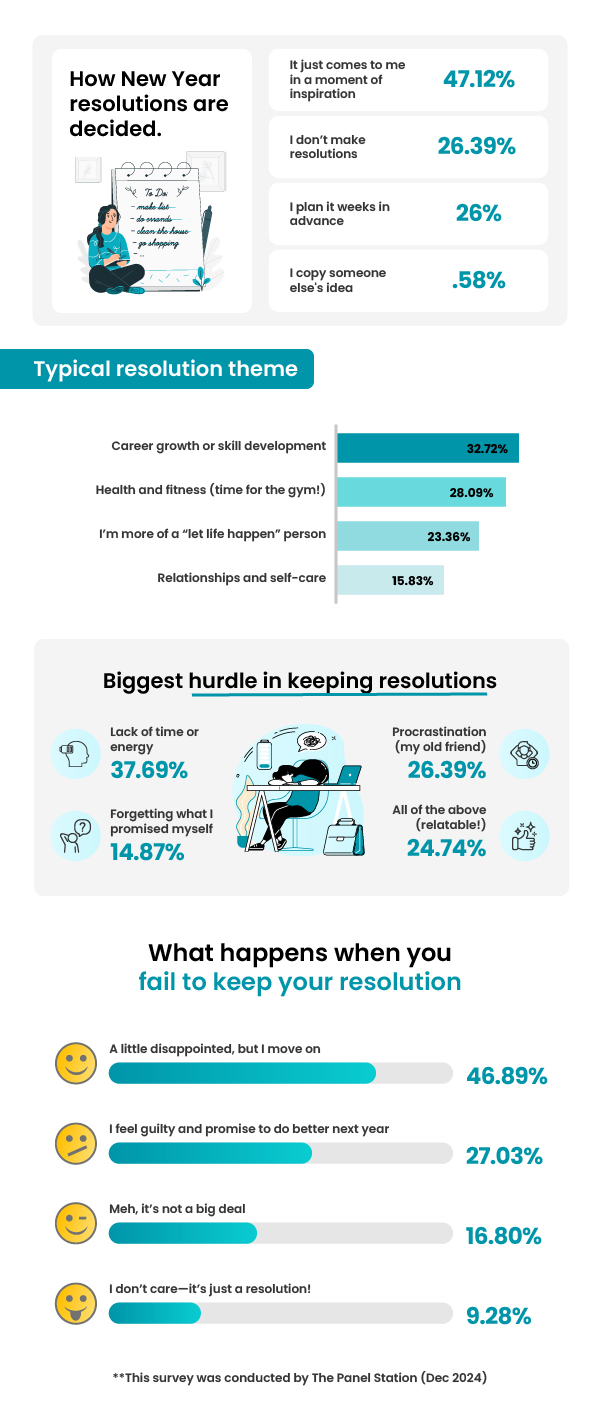New Year resolutions—a tradition as old as the calendar itself. Every year, millions of us swear to eat healthier, save more, or finally open that book we’ve been “meaning to read” for three years. Yet, by February, those carefully crafted plans dissolve like morning frost. Why is that? What drives us to make resolutions, and what makes them so hard to keep? We conducted a survey across 17 countries and got some fascinating insights into this age-old ritual. From how we choose our resolutions to the challenges we face, let’s dive into the trends, quirks, and struggles of this global phenomenon.
How New Year Resolutions Are Made
When it comes to deciding on resolutions, people seem to fall into two camps: the planners and the dreamers. According to the survey, 47.12% of respondents say their resolutions come to them in a sudden burst of inspiration like say it’s December 31st, you’re holding a glass of champagne, and the thought strikes, “This is the year I’ll learn French!” Sounds familiar?
On the other hand, 26% of people plan their resolutions weeks in advance. These are the meticulous folks who have spreadsheets, bullet journals, or color-coded charts to track their goals. A small but amusing 0.58% admit to copying someone else’s idea, while 26.39% skip resolutions altogether, perhaps having learned from past experiences.
This mix of spontaneity and planning reflects how diverse human behavior can be. Whether you’re an impromptu dreamer or a meticulous planner, it’s clear that resolutions tap into our universal desire for self-improvement.
Themes of New Year Resolutions
Now, let’s talk about what people actually resolve to do. The survey reveals three dominant themes: career growth, health and fitness, and relationships/self-care. Surprisingly, career growth takes the lead at 32.72%. It seems that professional ambitions are top-of-mind for many as the calendar turns. Maybe it’s the “New Year, New Job” mindset?
Health and fitness follow closely at 28.09%. Whether it’s joining a gym, starting a yoga routine, or simply walking more, the motivation to get healthier is evergreen. Relationships and self-care come in at 15.83%, a reminder that mental well-being is just as important as physical fitness.
Interestingly, 23.36% prefer to let life happen without rigid goals. This group might argue that spontaneity brings its own kind of growth. After all, isn’t life more fun when you don’t micromanage it?
Tracking Resolutions
So, how do people track their resolutions? The survey shows that 33.30% rely on good old pen and paper—simple, reliable, and oddly satisfying. Fancy apps and trackers attract 19.63%, catering to the tech-savvy crowd. Meanwhile, 27.21% wing it, hoping for the best. And let’s not forget the 19.86% who think tracking is just too much effort.
There’s a charm to the pen-and-paper approach. Scribbling progress in a notebook feels tangible and personal. Apps, while efficient, can sometimes feel clinical. And for those winging it, well, there’s beauty in chaos too. The takeaway? The best tracking method is the one that works for you.
Challenges in Keeping Resolutions
Why do resolutions so often fall by the wayside? The biggest culprit, cited by 37.69% of respondents, is a lack of time or energy. Between work, family, and endless to-do lists, it’s easy for resolutions to take a back seat.
Procrastination is another common hurdle, affecting 22.7%. We all know the drill: “I’ll start tomorrow… or maybe next week.”
To overcome these challenges, try breaking goals into smaller, manageable steps. Instead of “I’ll lose 20 pounds,” aim for “I’ll take a 20-minute walk each day.” Reward yourself for small wins, and don’t be too hard on yourself when you slip up. Remember, progress is progress, no matter how small.
Handling New Year Resolution Failures
What happens when resolutions fail? For 46.89% of people, the response is refreshingly healthy: a little disappointment, but they move on. Another 27.03% feel guilty and promise to do better next year. Interestingly, 16.80% adopt a “meh, no big deal” attitude, while 9.28% couldn’t care less.
The key to bouncing back from failure is perspective. Instead of seeing a broken resolution as the end, treat it as a learning opportunity. Restart, adjust your goals, or laugh it off and try again. As 43.42% of respondents suggest, restarting is always an option. After all, who says resolutions are limited to January 1st?
Resolution Longevity
Here’s a sobering statistic: only 34.96% of resolutions last all year. Most people—24.43%, to be precise—drop them within the first week. Another 14.83% hold on until February, while 25.78% make it to mid-year.
This pattern underscores the reality of human motivation. Initial enthusiasm often wanes, but that doesn’t mean the effort was wasted. Even a few months of trying can lead to positive changes. So, if your resolution fizzled out, take heart. You’ve likely gained something valuable, even if it wasn’t the outcome you envisioned.
Looking Ahead
As we look to 2025, saving money and eating healthier top the list of resolutions, with 45.91% and 20.29% of respondents choosing these goals.
If you’re gearing up for a fresh start, consider setting realistic and meaningful goals. Instead of vague aims like “get fit,” try specific ones like “walk 10,000 steps daily.” Use tools, apps, or even sticky notes to keep yourself motivated. Most importantly, remember that resolutions are about progress, not perfection.
To Sum it Up
New Year resolutions capture the universal human desire for growth and improvement. While they’re often challenging to keep, the effort itself is a step toward becoming better versions of ourselves. Whether you’re saving money, eating healthier, or just trying to keep your plants alive, every small win counts.
So, what did you resolve to achieve in 2025? Whatever it is, approach it with a mix of determination and humor. After all, the journey is just as important as the destination.





